Current Communicative Approaches Part II — Jack C.


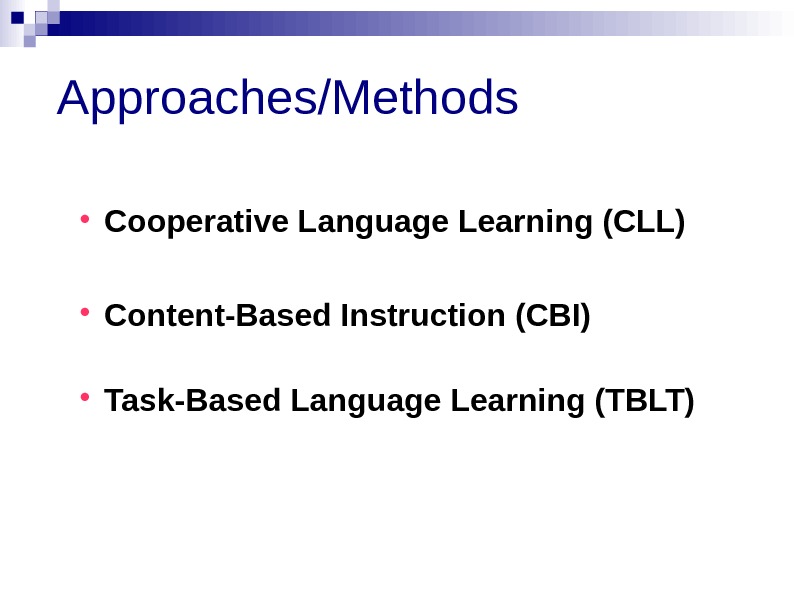
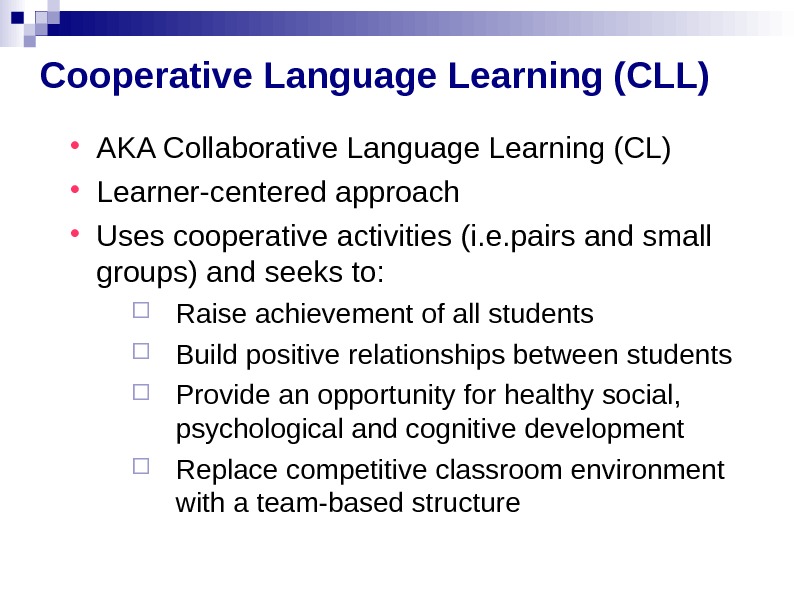
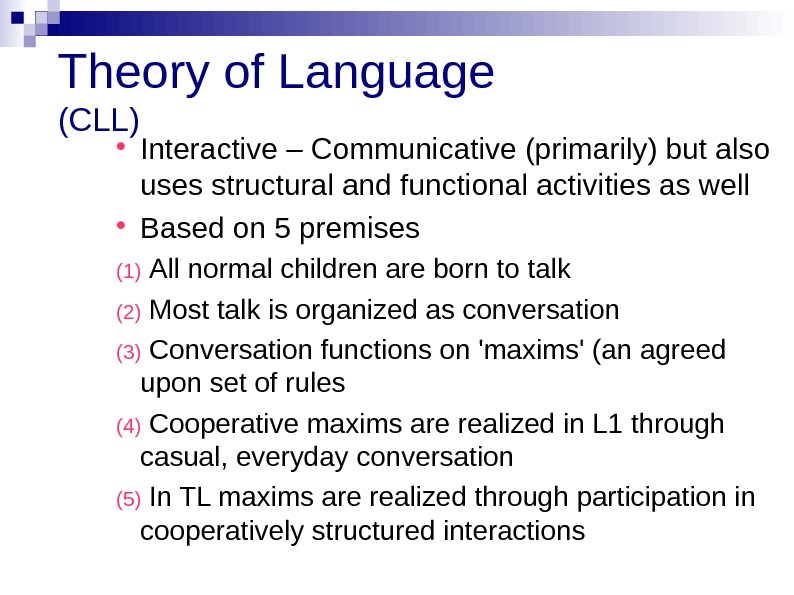

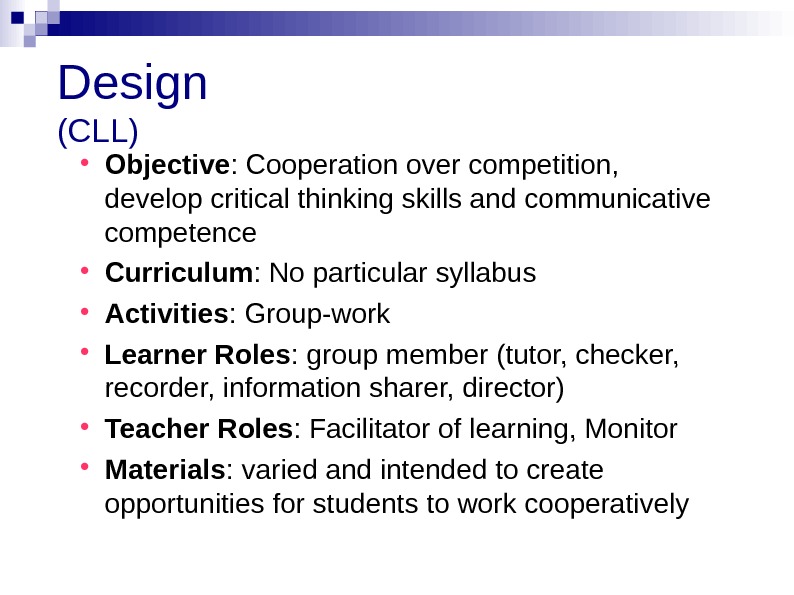
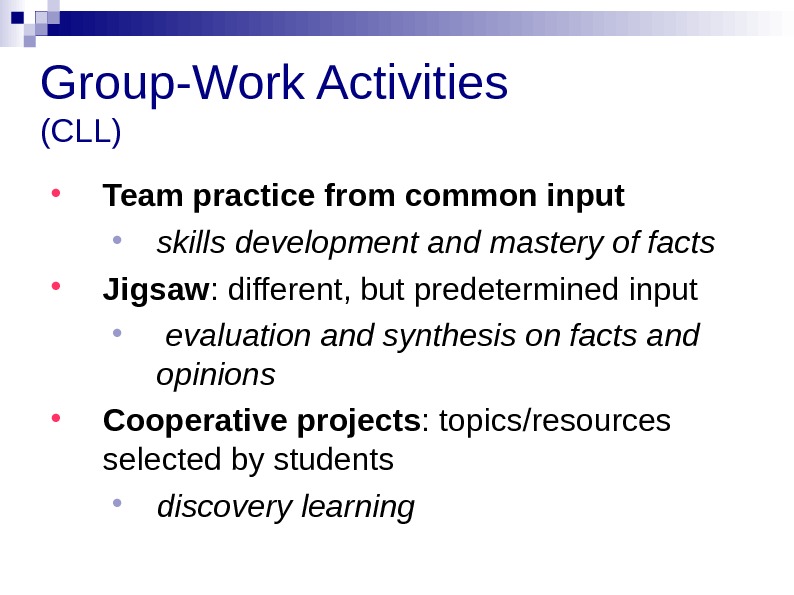
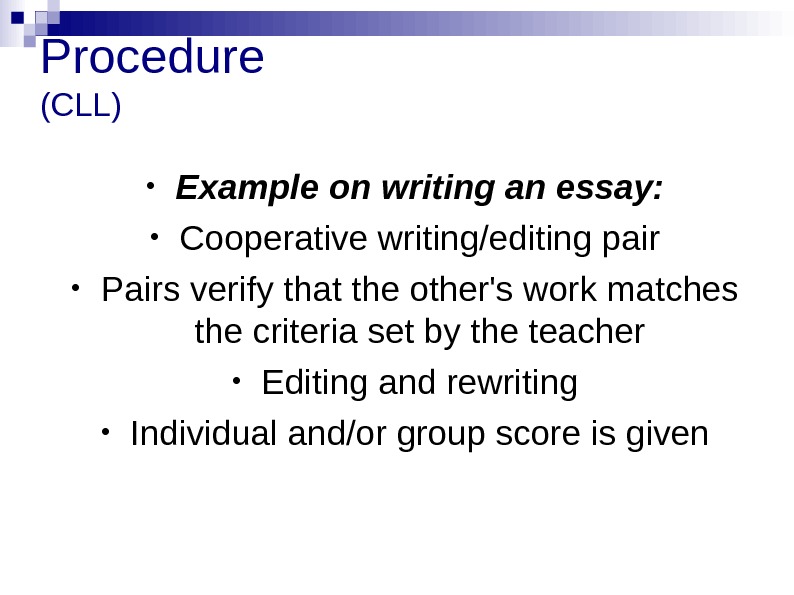

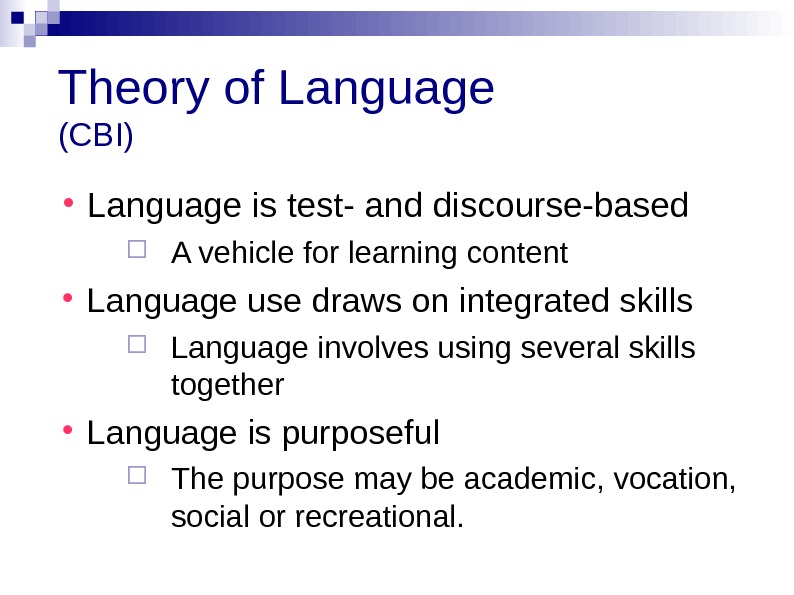
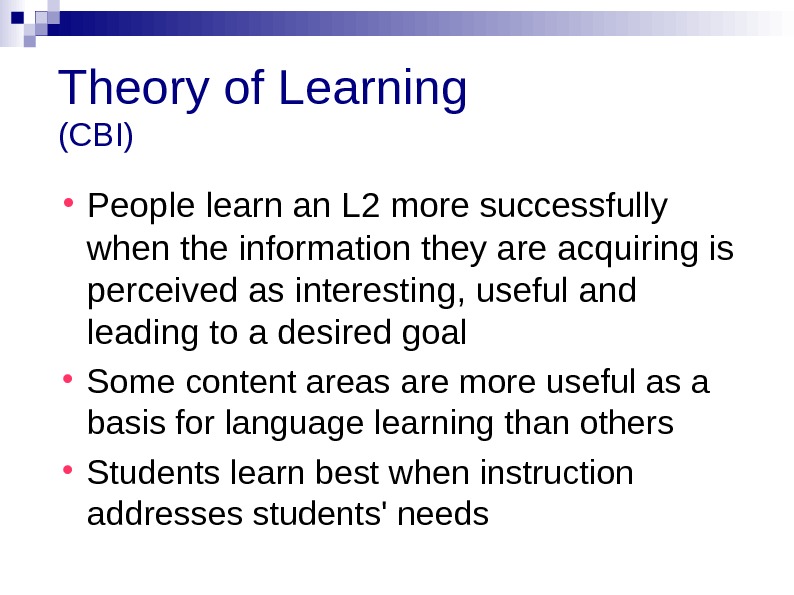
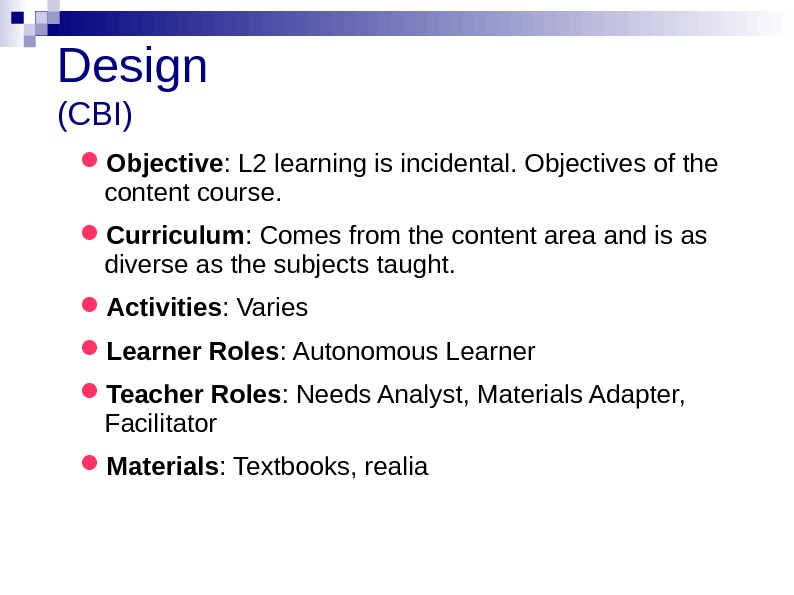
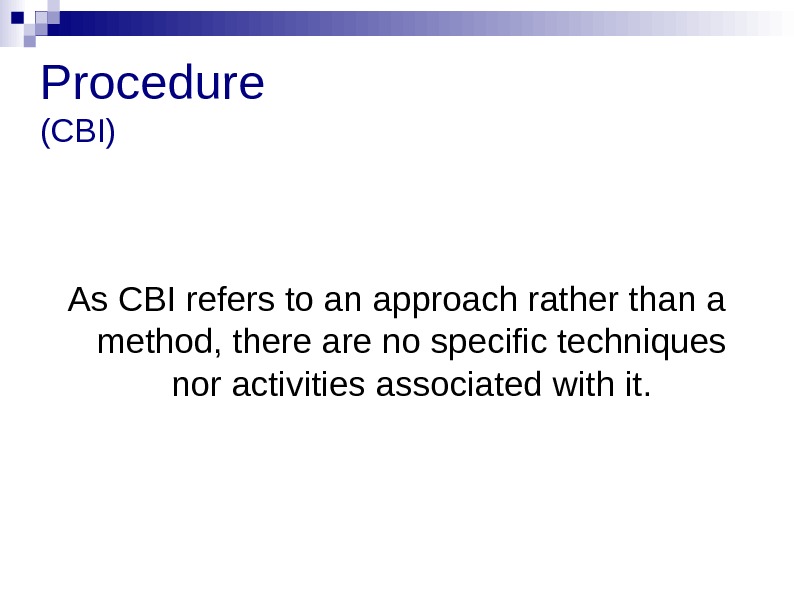
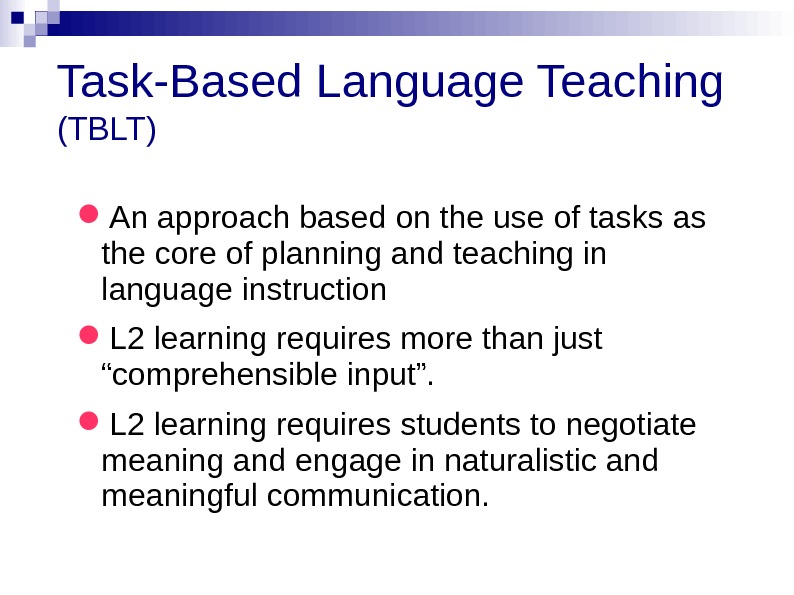
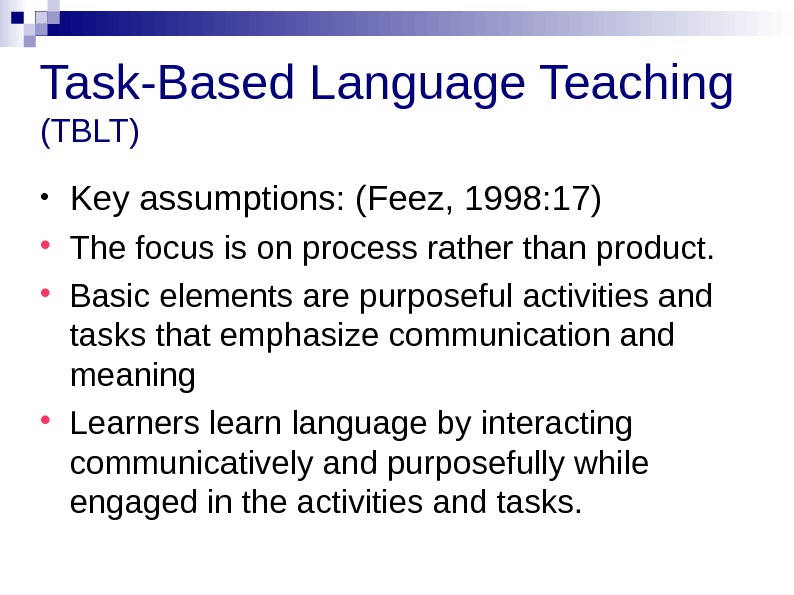
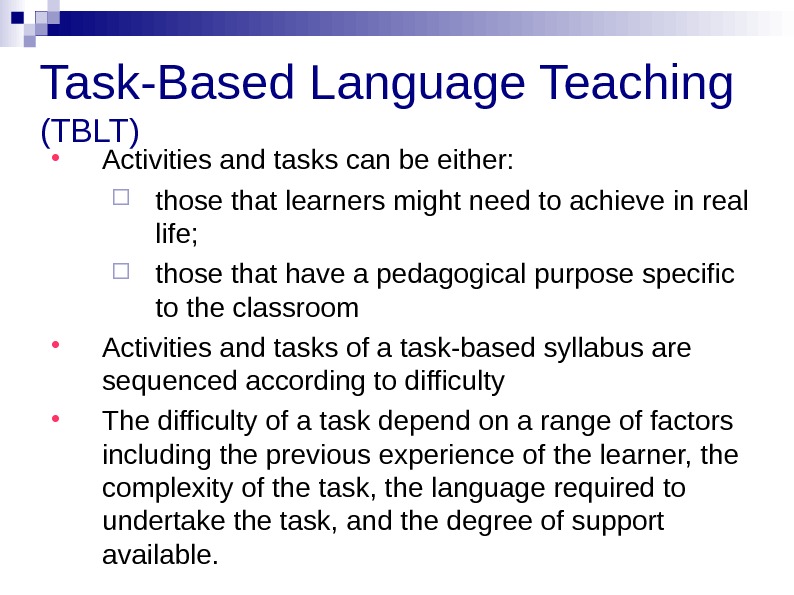
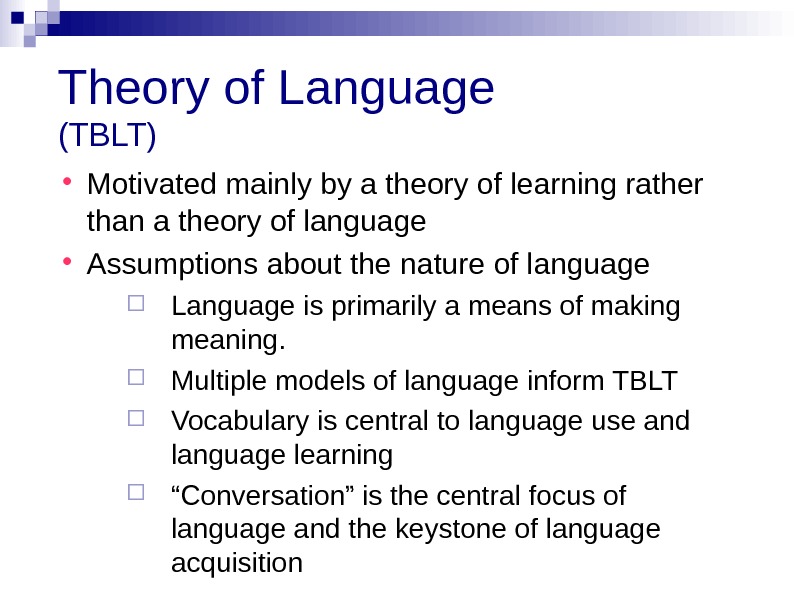
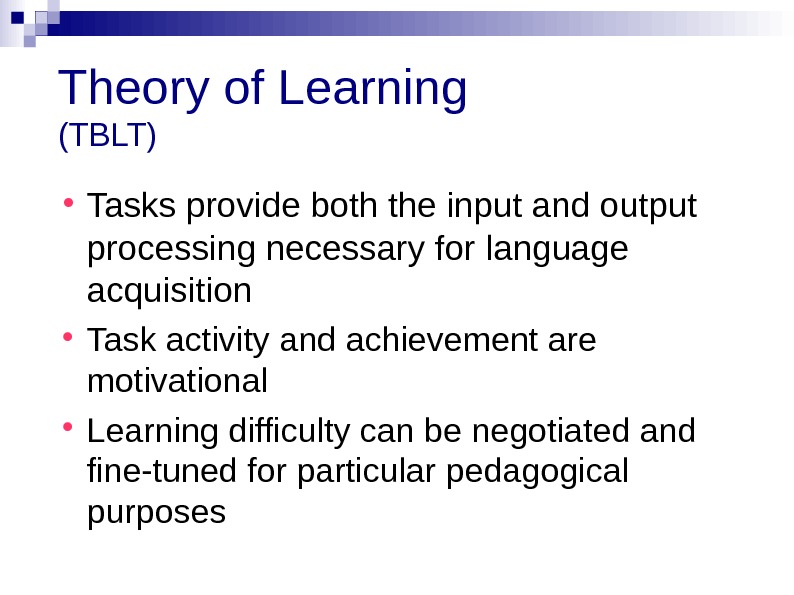
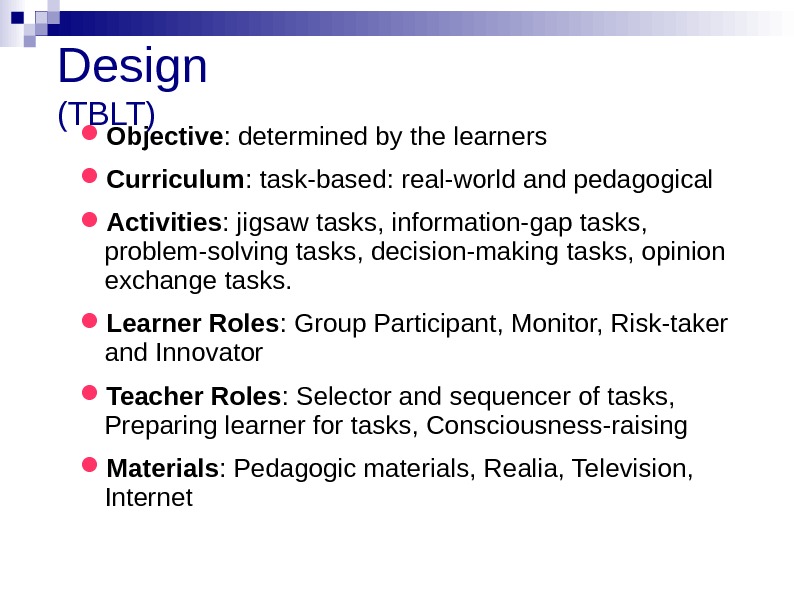
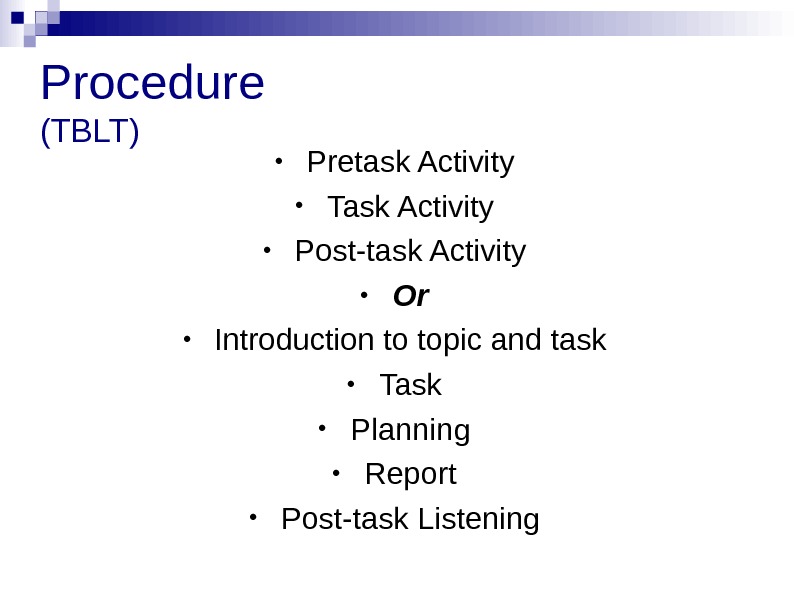
current_communicative_approaches_part_2.ppt
- Размер: 262 Кб
- Количество слайдов: 20
Описание презентации Current Communicative Approaches Part II — Jack C. по слайдам
 Current Communicative Approaches Part II — Jack C. Richards and Theodore S. Rodgers ( 2001) Approaches and Methods in Language Teaching , Cambridge University Press: New York.
Current Communicative Approaches Part II — Jack C. Richards and Theodore S. Rodgers ( 2001) Approaches and Methods in Language Teaching , Cambridge University Press: New York.
 Approaches/Methods Cooperative Language Learning (CLL) Content-Based Instruction (CBI) Task-Based Language Learning (TBLT)
Approaches/Methods Cooperative Language Learning (CLL) Content-Based Instruction (CBI) Task-Based Language Learning (TBLT)
 Cooperative Language Learning (CLL) AKA Collaborative Language Learning (CL) Learner-centered approach Uses cooperative activities (i. e. pairs and small groups) and seeks to: Raise achievement of all students Build positive relationships between students Provide an opportunity for healthy social, psychological and cognitive development Replace competitive classroom environment with a team-based structure
Cooperative Language Learning (CLL) AKA Collaborative Language Learning (CL) Learner-centered approach Uses cooperative activities (i. e. pairs and small groups) and seeks to: Raise achievement of all students Build positive relationships between students Provide an opportunity for healthy social, psychological and cognitive development Replace competitive classroom environment with a team-based structure
 Theory of Language (CLL) Interactive – Communicative (primarily) but also uses structural and functional activities as well Based on 5 premises (1) All normal children are born to talk (2) Most talk is organized as conversation (3) Conversation functions on ‘maxims’ (an agreed upon set of rules (4) Cooperative maxims are realized in L 1 through casual, everyday conversation (5) In TL maxims are realized through participation in cooperatively structured interactions
Theory of Language (CLL) Interactive – Communicative (primarily) but also uses structural and functional activities as well Based on 5 premises (1) All normal children are born to talk (2) Most talk is organized as conversation (3) Conversation functions on ‘maxims’ (an agreed upon set of rules (4) Cooperative maxims are realized in L 1 through casual, everyday conversation (5) In TL maxims are realized through participation in cooperatively structured interactions
 Theory of Learning (CLL) Stress on the central role of social interaction in learning Development of critical thinking skills is central to all learning Critical Thinking : the process of thinking that questions assumptions. It is a way of deciding whether a claim is true, false; sometimes true, or partly true (wikipedia. org) skills include observation, interpretation, analysis, inference, evaluation, explanation, and meta-cognition (wikipedia. org)
Theory of Learning (CLL) Stress on the central role of social interaction in learning Development of critical thinking skills is central to all learning Critical Thinking : the process of thinking that questions assumptions. It is a way of deciding whether a claim is true, false; sometimes true, or partly true (wikipedia. org) skills include observation, interpretation, analysis, inference, evaluation, explanation, and meta-cognition (wikipedia. org)
 Design (CLL) Objective : Cooperation over competition, develop critical thinking skills and communicative competence Curriculum : No particular syllabus Activities : Group-work Learner Roles : group member (tutor, checker, recorder, information sharer, director) Teacher Roles : Facilitator of learning, Monitor Materials : varied and intended to create opportunities for students to work cooperatively
Design (CLL) Objective : Cooperation over competition, develop critical thinking skills and communicative competence Curriculum : No particular syllabus Activities : Group-work Learner Roles : group member (tutor, checker, recorder, information sharer, director) Teacher Roles : Facilitator of learning, Monitor Materials : varied and intended to create opportunities for students to work cooperatively
 Group-Work Activities (CLL) Team practice from common input skills development and mastery of facts Jigsaw : different, but predetermined input evaluation and synthesis on facts and opinions Cooperative projects : topics/resources selected by students discovery learning
Group-Work Activities (CLL) Team practice from common input skills development and mastery of facts Jigsaw : different, but predetermined input evaluation and synthesis on facts and opinions Cooperative projects : topics/resources selected by students discovery learning
 Procedure (CLL) • Example on writing an essay: • Cooperative writing/editing pair • Pairs verify that the other’s work matches the criteria set by the teacher • Editing and rewriting • Individual and/or group score is given
Procedure (CLL) • Example on writing an essay: • Cooperative writing/editing pair • Pairs verify that the other’s work matches the criteria set by the teacher • Editing and rewriting • Individual and/or group score is given
 Content-Based Instruction (CBI) L 2 teaching is centered around the content the students acquire, not the L 2 itself Students learn language as a by-product of learning real-world content Grounded on 2 central principals: (1) People learn an L 2 more successfully when they use the language as a means of acquiring information (2) CBI better reflects learners’ needs for learning a second language
Content-Based Instruction (CBI) L 2 teaching is centered around the content the students acquire, not the L 2 itself Students learn language as a by-product of learning real-world content Grounded on 2 central principals: (1) People learn an L 2 more successfully when they use the language as a means of acquiring information (2) CBI better reflects learners’ needs for learning a second language
 Theory of Language (CBI) Language is test- and discourse-based A vehicle for learning content Language use draws on integrated skills Language involves using several skills together Language is purposeful The purpose may be academic, vocation, social or recreational.
Theory of Language (CBI) Language is test- and discourse-based A vehicle for learning content Language use draws on integrated skills Language involves using several skills together Language is purposeful The purpose may be academic, vocation, social or recreational.
 Theory of Learning (CBI) People learn an L 2 more successfully when the information they are acquiring is perceived as interesting, useful and leading to a desired goal Some content areas are more useful as a basis for language learning than others Students learn best when instruction addresses students’ needs
Theory of Learning (CBI) People learn an L 2 more successfully when the information they are acquiring is perceived as interesting, useful and leading to a desired goal Some content areas are more useful as a basis for language learning than others Students learn best when instruction addresses students’ needs
 Design (CBI) Objective : L 2 learning is incidental. Objectives of the content course. Curriculum : Comes from the content area and is as diverse as the subjects taught. Activities : Varies Learner Roles : Autonomous Learner Teacher Roles : Needs Analyst, Materials Adapter, Facilitator Materials : Textbooks, realia
Design (CBI) Objective : L 2 learning is incidental. Objectives of the content course. Curriculum : Comes from the content area and is as diverse as the subjects taught. Activities : Varies Learner Roles : Autonomous Learner Teacher Roles : Needs Analyst, Materials Adapter, Facilitator Materials : Textbooks, realia
 Procedure (CBI) As CBI refers to an approach rather than a method, there are no specific techniques nor activities associated with it.
Procedure (CBI) As CBI refers to an approach rather than a method, there are no specific techniques nor activities associated with it.
 Task-Based Language Teaching (TBLT) An approach based on the use of tasks as the core of planning and teaching in language instruction L 2 learning requires more than just “comprehensible input”. L 2 learning requires students to negotiate meaning and engage in naturalistic and meaningful communication.
Task-Based Language Teaching (TBLT) An approach based on the use of tasks as the core of planning and teaching in language instruction L 2 learning requires more than just “comprehensible input”. L 2 learning requires students to negotiate meaning and engage in naturalistic and meaningful communication.
 Task-Based Language Teaching (TBLT) • Key assumptions: (Feez, 1998: 17) The focus is on process rather than product. Basic elements are purposeful activities and tasks that emphasize communication and meaning Learners learn language by interacting communicatively and purposefully while engaged in the activities and tasks.
Task-Based Language Teaching (TBLT) • Key assumptions: (Feez, 1998: 17) The focus is on process rather than product. Basic elements are purposeful activities and tasks that emphasize communication and meaning Learners learn language by interacting communicatively and purposefully while engaged in the activities and tasks.
 Task-Based Language Teaching (TBLT) Activities and tasks can be either: those that learners might need to achieve in real life; those that have a pedagogical purpose specific to the classroom Activities and tasks of a task-based syllabus are sequenced according to difficulty The difficulty of a task depend on a range of factors including the previous experience of the learner, the complexity of the task, the language required to undertake the task, and the degree of support available.
Task-Based Language Teaching (TBLT) Activities and tasks can be either: those that learners might need to achieve in real life; those that have a pedagogical purpose specific to the classroom Activities and tasks of a task-based syllabus are sequenced according to difficulty The difficulty of a task depend on a range of factors including the previous experience of the learner, the complexity of the task, the language required to undertake the task, and the degree of support available.
 Theory of Language (TBLT) Motivated mainly by a theory of learning rather than a theory of language Assumptions about the nature of language Language is primarily a means of making meaning. Multiple models of language inform TBLT Vocabulary is central to language use and language learning “ Conversation” is the central focus of language and the keystone of language acquisition
Theory of Language (TBLT) Motivated mainly by a theory of learning rather than a theory of language Assumptions about the nature of language Language is primarily a means of making meaning. Multiple models of language inform TBLT Vocabulary is central to language use and language learning “ Conversation” is the central focus of language and the keystone of language acquisition
 Theory of Learning (TBLT) Tasks provide both the input and output processing necessary for language acquisition Task activity and achievement are motivational Learning difficulty can be negotiated and fine-tuned for particular pedagogical purposes
Theory of Learning (TBLT) Tasks provide both the input and output processing necessary for language acquisition Task activity and achievement are motivational Learning difficulty can be negotiated and fine-tuned for particular pedagogical purposes
 Design (TBLT) Objective : determined by the learners Curriculum : task-based: real-world and pedagogical Activities : jigsaw tasks, information-gap tasks, problem-solving tasks, decision-making tasks, opinion exchange tasks. Learner Roles : Group Participant, Monitor, Risk-taker and Innovator Teacher Roles : Selector and sequencer of tasks, Preparing learner for tasks, Consciousness-raising Materials : Pedagogic materials, Realia, Television, Internet
Design (TBLT) Objective : determined by the learners Curriculum : task-based: real-world and pedagogical Activities : jigsaw tasks, information-gap tasks, problem-solving tasks, decision-making tasks, opinion exchange tasks. Learner Roles : Group Participant, Monitor, Risk-taker and Innovator Teacher Roles : Selector and sequencer of tasks, Preparing learner for tasks, Consciousness-raising Materials : Pedagogic materials, Realia, Television, Internet
 Procedure (TBLT) • Pretask Activity • Task Activity • Post-task Activity • Or • Introduction to topic and task • Task • Planning • Report • Post-task Listening
Procedure (TBLT) • Pretask Activity • Task Activity • Post-task Activity • Or • Introduction to topic and task • Task • Planning • Report • Post-task Listening

